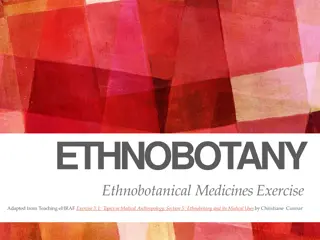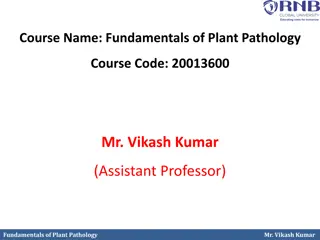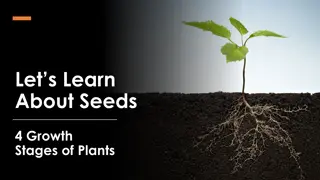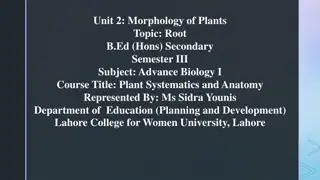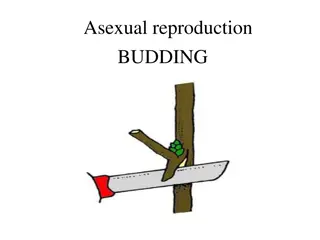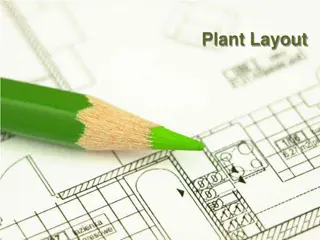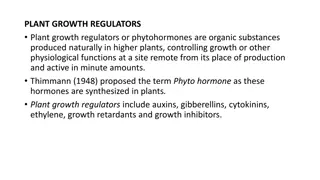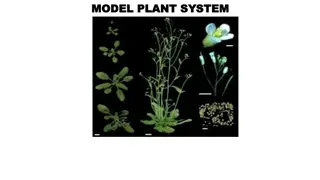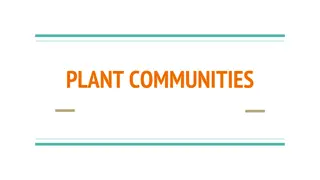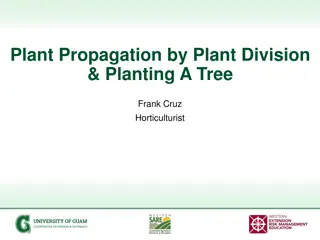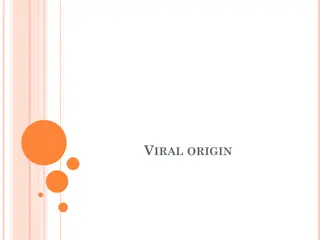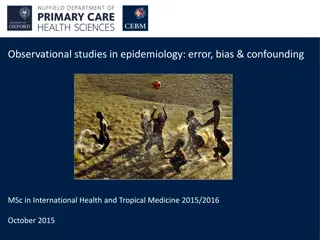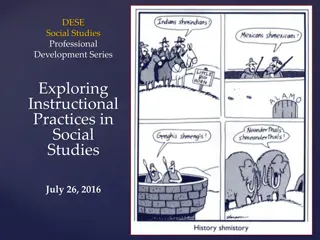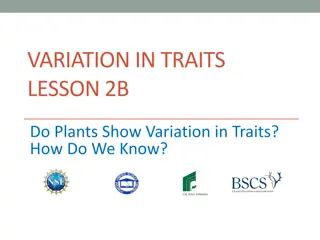Exploring Plant Fossils in Ethnobotanical Studies
Ethnobotany relies on various sources of data, including plant fossils. Fossils play a crucial role in identifying plants used by ancient societies, with specialized fields like paleobotany reconstructing past environments. Different types of plant fossils like coprolites, petrifactions, cast-on-incrustations, and compaction provide valuable insights into ancient plant-people relationships.
Download Presentation

Please find below an Image/Link to download the presentation.
The content on the website is provided AS IS for your information and personal use only. It may not be sold, licensed, or shared on other websites without obtaining consent from the author. Download presentation by click this link. If you encounter any issues during the download, it is possible that the publisher has removed the file from their server.
E N D
Presentation Transcript
SOURCES OF DATA AND METHODS OF STUDY Class: MS Semester II Course Title: Recent Trends in Ethnobotany Instructor: Dr. ARUSA AFTAB Department of Botany LAHORE COLLEGE FOR WOMEN UNIVERSITY LAHORE
SOURCES OF DATA AND METHODS OF STUDY Sources of information depicting past and present relationship of plants and human beings are the major tools of study of ethnobotany. Schultes (1962) and Jain (1964) mentioned the sources are archaeological, literary, herbarium and field resources. These sources may vary and depending upon the interests, training and objective of investigator.
1. FOSSILS Different kind of plant remains of the past seen to be the only major tool for the collection ,identification and documentation of plants used by people of pre- and pro-historic periods. Such ethnobotanical studies. type of specialized studies are generally known as paleo- Paleobotany is the branch of botany identification of plant remains from geological contexts, and their use for the biological reconstruction of past environment , and the evolutionary history of pants .. https://en.wikipedia.org/wiki/Paleobotany dealing with the recovery and
TYPES OF PLANT FOSSILS Coprolites These are fossilized droppings of animals provide another tool ;they are analyzed what feed were being consumed by animals in ancient times. Birbal Sahni institute of Paleobotany, Lucknow is one of the best institute for such studies in India. Petrifactions or Mineralized plants the original cell of the plant tissue is retained by means of some minerals like, silica etc. These mineral has infiltrated the tissues. sometimes the material of original plant may be preserved e.g. coal balls, Silicified wood etc.(https://biologyboom.com/fossil-and-fossilization/)
Cast on incrustations: In this type of plant fossil, the form of plant is preserved as a cast. The cast result from the liking of a cavity formed by decay of tissues of plant part. Compressions: In this type of plant fossil, the external form of plant modifies and leaves impressions on the sediment which over lie it.(https://biologyboom.com/fossil-and-fossilization/)
Compaction or Mummified plants: the plants or their parts get compressed by vertical pressure against one another. Mostly plant rudiments found in pea and coal as compactions. Coal or coal balls are the important sources of plant fossils. Coals are irregular or sub spherical mass of calcium or magnesium carbonates (or some other mineral matter. (https://biologyboom.com/fossil-and-fossilization/
Impressions: In this type of fossil, the roots, stems, leaves, fruits and seeds are preserved as impressions in such a fashion that they seem to be the actual dried specimens laid on the stone. Amber: Coniferous plants exudates resinous substance. It drops on the floor of forests. It accumulates and hardened over ages. Insects, fragments of plants and other animals get preserved in it and become fossilized. It is called ambers. (https://biologyboom.com/fossil-and-fossilization/)
2.ARCHAEOLOGICAL RESOURCES India has a rich treasure of archaeological sculptures. Writings on the stones or on the stupas of different periods are also available. These sculptures and writings are sometimes having indication of their uses in ancient times. Recently an attempt has been made by Sitholey (1976) to describe some plants from archeological material of gateways of the Great Stupa of Sanchi (100 B.C) and railing of Bharhut Stupa (200B.C.) depiction of plants and provide His work deals with about 40 representation of plants. Archaeological survey of India can be the best source for procuring such materials. These studies are helpful in identification and documentation of plants in historical perspectives .studies on carvings of plants,temples,on rocks in caves are also interesting aspects .
3. TRAVELOGUES OBSOLETE LITERATURE AND A number of published or handwritten documents lie in the holdings of libraries ,museums and individuals and actually remains neglected for a long time. Such literature is sometimes called as grey literature. Sometimes information in such documents names are mentioned ,spellings are wrong and often lack phonetics indications. is very vague. Mostly local These provide valuable information as to how some plants species influenced the social and cultural lifestyle of tribes .If proper studies are initiated on ancient literature ,vast data on plants and their different uses can be known(University Botany- Iii : (Plant Taxonomy, Plant Embryology, Plant ..., Volume 3 By S.M. Reddy)
TRAVELOGUES CONT. Travellers mentioned local uses of plants in their writings or travel accounts. Although travelogues don t use exhaustive list of plants, but they use sometimes names of dominant plants ,medicinal plant species and other economically imp species.
4.SANSKRIT LITERATURE Sanskrit literature can be said to present tradition of Indian culture through ages Preliminary studies on some floras in Sanskrit literature have recently been made by Banerjee and Sensarma. They have listed more than 1000 plants names are mentioned in Ramayana, Rigveda,Mahabaharta, and various Puranas and Sastras etc. But the identification of various sp.is not easy because sometimes only names are given without mentioning even a single character.
5.SCULPTURES ON TEMPLES For the ethnobotanical studies the sculptures on temples and also on other religious monuments are good source of information. The arts and paintings depict number of plants species known during those times. Shakti gupta (1986) of Delhi university conducted an extensive survey on the sculptures on temples of India .she unfolded many interesting details on the relationships between the tribal and plants shown in sculptures. University Botany- Iii : (Plant Taxonomy, Plant Embryology, Plant ..., Volume 3 By S.M. Reddy
6.ETHNOGRAPHIES Some ethnographers have extensively dealt with the plants used by tribals for various purposes and their ethnographies are useful for ethnobotanical studies. Advantage of ethnographies is that such works are written by qualified anthropologists and the relationship is usually dealt in an exhaustive and scientific manners .
7.GAZETTEERS Important plants of a particular region are usually highlighted ,sometimes comparison of the data in very old and the recent gazetteers provides interesting information on change in uses and occurrence of a plant .
8.HERBARIA AND MUSEUM Herbarium is collection or preservation of pressed labeled and dried plant specimens arranged specimens by a classification scheme. Museum is preservation of dead and decaying plants and animals. The plants collectors notes on labels of herbarium sheets and museum specimens are understood to be one of the best sources for collection of valuable ethnobotanical information. Both these sources contain plant collections from various parts of the world. These collection provide useful data on the place (locality) of collection along with date, time of flowering and fruiting. These herbaria sheets also information on vernacular name and economic importance. University Botany- Iii :(PlantTaxonomy, Plant Embryology, Plant ...,Volume 3 By S.M.Reddy
HERBARIA AND MUSEUM CONT. This information has more value than from other sources. It is the first hand information ,the data concerning locality ,people and time are also noted along collectors notes on herbarium sheets or museum specimens and the botanical identity of the plant is fixed. The biggest and the oldest herbarium of India is Central National Herbarium of Botanical Survey of India.
9.REPORTS OF FOREST DEPARTMENTS Various units of the forest departments usually prepare annual reports and working plants for the extraction of major and minor forest produce. Through these reports a number of useful information can be gathered by scrutiny of old and new reports . These reports contains botanical or well-known commercial names which help much in identification of plants species .
10.FIELD STUDIES By field visits and field studies valuable data can be generated in from tribals areas in ethnobotany. Through field visits one can observe the way they use various plants and plants products for different purposes and obtained data can be used for producing food,medicines,textiles. Field observation comprises of 2 stages. 1. involvement of tribals who are well known with use of that area plants 2. Collection of useful plants of a specific area and then showing these plants to tribals to get additional information on their importance. Through these two stages vernacular names of plants will also be recorded. (University Botany- Iii : (Plant Taxonomy, Plant Embryology, Plant ..., Volume 3 By S.M. Reddy)
RECOMMENDED BOOKS S.K.Jain & V. Mudgal (1999) - A hand book of Ethnobotany, Bishen Singh Mahendra Pal Singh, Dehra Dun, India. Zebta Khan, Alan Hamilton and Ashiq Ahmad Khan, (2002), Curriculum Development in Applied Ethnobotany, WWF. Pakistan.











